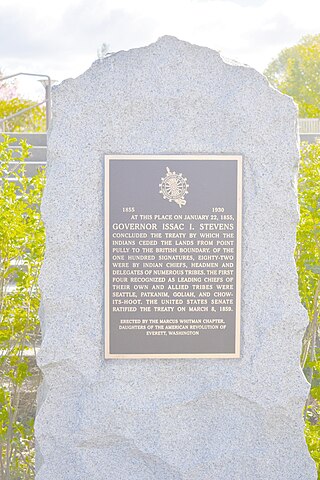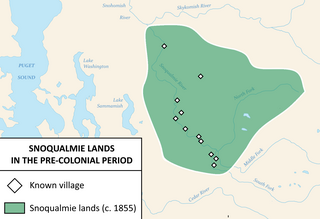
The Muckleshoot Indian Tribe, also known as the Muckleshoot Tribe, is a federally-recognized tribe located in Auburn, Washington. The tribe governs the Muckleshoot Reservation and is composed of descendants of the Duwamish, Stkamish, Smulkamish, Skopamish, Yilalkoamish, and Upper Puyallup peoples. The Muckleshoot Indian Tribe was formally established in 1936, after the Indian Reorganization Act of 1934, but its origins lie in the creation of the Muckleshoot Reservation in 1874 and the treaties of Medicine Creek (1854) and Point Elliott (1855).

King County is a county located in the U.S. state of Washington. The population was 2,269,675 in the 2020 census, making it the most populous county in Washington, and the 12th-most populous in the United States. The county seat is Seattle, also the state's most populous city.

Fall City is an unincorporated community and census-designated place (CDP) in King County, Washington, United States, 25 miles (40 km) east of Seattle. The community lies along the Snoqualmie River and Raging River. The population was 2,032 as of the 2020 census.

North Bend is a city in King County, Washington, United States, on the outskirts of the Seattle metropolitan area. The population was 7,461 at the 2020 census.

The Snoqualmie River is a 45-mile (72 km) long river in King County and Snohomish County in the U.S. state of Washington. The river's three main tributaries are the North, Middle, and South Forks, which drain the west side of the Cascade Mountains near the town of North Bend and join near the town of Snoqualmie just above the Snoqualmie Falls. After the falls the river flows north through rich farmland and the towns of Fall City, Carnation, and Duvall before meeting the Skykomish River to form the Snohomish River near Monroe. The Snohomish River empties into Puget Sound at Everett. Other tributaries of the Snoqualmie River include the Taylor River and the Pratt River, both of which enter the Middle Fork, the Tolt River, which joins at Carnation, and the Raging River at Fall City.

The Duwamish are a Lushootseed-speaking Southern Coast Salish people in western Washington, and the Indigenous people of metropolitan Seattle.

Chief Leschi was a chief of the Nisqually Indian Tribe of southern Puget Sound, Washington, primarily in the area of the Nisqually River.

The Colville Indian Reservation is an Indian reservation in the Northwestern United States, in north central Washington, inhabited and managed by the Confederated Tribes of the Colville Reservation, which are federally recognized.

The Snoqualmie Indian Tribe is a federally recognized tribe of Snoqualmie people. They are Coast Salish Native American peoples from the Snoqualmie Valley in east King and Snohomish Counties in Washington state. Other names for the Snoqualmies include Snoqualmu, Snoqualmoo, Snoqualmick, Snoqualamuke, and Snuqualmi.

The Yakima War (1855–1858), also referred to as the Plateau War or Yakima Indian War, was a conflict between the United States and the Yakama, a Sahaptian-speaking people of the Northwest Plateau, then part of Washington Territory, and the tribal allies of each. It primarily took place in the southern interior of present-day Washington. Isolated battles in western Washington and the northern Inland Empire are sometimes separately referred to as the Puget Sound War and the Coeur d'Alene War, respectively.
The Sammamish people are a Lushootseed-speaking Southern Coast Salish people. They are indigenous to the Sammamish River Valley in central King County, Washington. The Sammamish speak Lushootseed, a Coast Salish language which was historically spoken across most of Puget Sound, although its usage today is mostly reserved for cultural and ceremonial practices.

The Treaty of Point Elliott of 1855, or the Point Elliott Treaty,—also known as the Treaty of Point Elliot / Point Elliot Treaty—is the lands settlement treaty between the United States government and the Native American tribes of the greater Puget Sound region in the recently formed Washington Territory, one of about thirteen treaties between the U.S. and Native Nations in what is now Washington. The treaty was signed on January 22, 1855, at Muckl-te-oh or Point Elliott, now Mukilteo, Washington, and ratified 8 March and 11 April 1859. Between the signing of the treaty and the ratification, fighting continued throughout the region. Lands were being occupied by European-Americans since settlement in what became Washington Territory began in earnest from about 1845.

Chief Patkanim was chief of the Snoqualmoo (Snoqualmie) and Snohomish tribe in what is now modern Washington state.
Kanim Falls is the major waterfall on the North Fork of the Snoqualmie River. It is located at the outlet of Lake Kanim and is near the source of the North Fork of the Snoqualmie River. The falls were named after Chief Jerry Kanim who was the leader of Snoqualmie people.

Interstate 90 (I-90), designated as the American Veterans Memorial Highway, is a transcontinental Interstate Highway that runs from Seattle, Washington, to Boston, Massachusetts. It crosses Washington state from west to east, traveling 298 miles (480 km) from Seattle across the Cascade Mountains and into Eastern Washington, reaching the Idaho state line east of Spokane. I-90 intersects several of the state's other major highways, including I-5 in Seattle, I-82 and U.S. Route 97 (US 97) near Ellensburg, and US 395 and US 2 in Spokane.

The Snoqualmie Valley School District is located in King County, Washington about 40 miles (64 km) from Seattle at the foothills of Snoqualmie Pass. It encompasses over 400 square miles (1,000 km2), making it geographically one of the largest school districts in Washington state. The district has an enrollment of approximately 7,200 students.

The Snoqualmie people are a Lushootseed-speaking Southern Coast Salish people indigenous to the Snoqualmie Valley, located in east King and Snohomish counties in the state of Washington.
Lake Kanim is a set of small freshwater lakes located on a clif of the south skirt of Lennox Mountain, in King County, Washington. Lake Kanim is the nascent source of the North Fork of the Snoqualmie River. The lake and its accompanying waterfall were named after Jerry Kanim who was the leader of Snoqualmie people.
Paradise Lakes are a set of three small freshwater lakes located on a clif of the north skirt of Bare Mountain, in King County, Washington. Paradise Lakes sit in a bowl formed by a ridge that connects to the south ridge of Lennox Mountain. Paradise Lakes have an outflow that is a tributary of the North Fork of the Snoqualmie River from its source, Lake Kanim.

The Skykomish are a Lushootseed-speaking Coast Salish people indigenous to the Skykomish Valley in the Cascade Mountains of Washington.
















